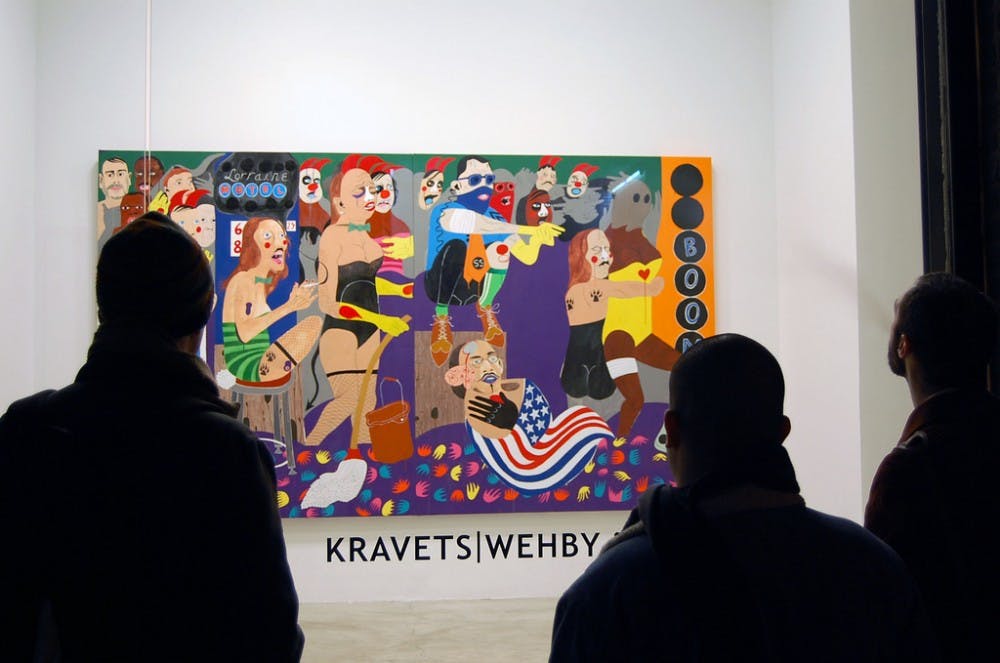This semester, the Nasher Museum of Art will be exhibiting a collection of the works of Nina Chanel Abney under the title “Royal Flush.” Abney’s work has been highly acclaimed, and while it has been shown in galleries and exhibitions across the country, this will be her first solo exhibition in N.C. Abney has been described by Vanity Fair as a champion of the Black Lives Matter movement, and while much of her work deals with issues of racial dynamics, to ascribe a single theme to her portfolio would be an oversimplification.
“The show is a ten-year survey of her career beginning around 2007, and the subjects that she takes on run the gamut from criminal justice to gender and racial dynamics and wealth inequity,” said Marshall Price, Nancy Hanks curator of modern and contemporary art at the Nasher.
However, if Abney’s work was socially relevant at the beginning of her career, it has only grown more so over time. Given the current political climate and the importance that racial dynamics have played in recent national dialogue, “Royal Flush” seems particularly relevant.
“Community, and issues of policing in community are recent topics for her for which she received a lot of attention,” Price said. “It’s really amazing… to see how prescient some of the earlier work is in terms of taking on certain subjects. For example, she did a small series of paintings about seven years ago that took on interracial violence and police violence, and this was several years before the issue became so prominent in the country’s consciousness.”
The issues that Abney addresses in her work are monumental, and while much discussion has occurred around them, in recent years it has often felt as if civil discourse is impossible. Adding to the difficulty of meaningfully addressing these subjects is the fact that media treatment of sensitive issues is often highly dramatic, which can stifle meaningful conversation. In many ways, Abney’s work reflects this trend and responds to the inundation of information that many people experience.
“It’s narrative, it’s colorful, it’s in many cases quite large,” Price said. “But it’s rendered using language that is relatable to a large swath of the younger generation of our country, a generation that may have been raised on multiple screens or what have you, a generation that’s processing many streams of information simultaneously.”
And, fittingly, Abney deftly recreates the sensation of information overload in her work. One recurring element is the incorporation of text into her paintings. When present, the writing is usually only a few words in large, block letters and is abrupt, jarring and fragmented. Words are short, but powerful— “GOD,” “GIRL,” “BLACK”—cutting through the sometimes eclectic images to establish meaning. In this way, Abney’s work reflects the ways in which we communicate with each other: after all, we live in an era when communication is fragmentary and emotional, and public outbursts and Twitter tirades are confined to 140 characters.
Despite the in-your-face imagery and eclectic symbolism of her paintings, Abney’s work is at its core representational. It addresses specific subjects, and in many cases represents real people, separating it from abstract art, which disdains the “figurative” tradition to which Abney’s work belongs.
“Something else that really resonates with me [about Abney’s work] is that it has historical precedence,” Price said, describing how figurative art was also produced during and in response to the Civil Rights movement. “I think that for Nina, she’s creating this sort of figurative work, but very much updated for the digital era.”
In fact, there are many other aspects of modern culture and interaction that permeate Abney’s work. In one work that will be displayed in the “Royal Flush” exhibition, “Faces are reminiscent of and inspired by emojis,” Price said. “The way that she’s melded references to more conventional figure paintings with this visual language of emojis and emoticons has really been fantastic and an innovative approach to rendering figure.”
Perhaps because the artistic language that she uses is so in tune with modern modes of communication, Abney’s work has been very well received by younger audiences in the past. However, her appeal has also been broad, and has captured the attention of many people in modern art circles.
“I think it will resonate with the college community, and hopefully also with the larger community of the Triangle,” Price said. “I think it’s the type of work that hopefully will provoke thought, and raise consciousness, and perhaps even spur action.”
Following its stint at the Nasher, “Royal Flush” will travel to the Chicago Cultural Center, and planning is underway to show the collection at the Institute of Contemporary Art in Los Angeles.
Get The Chronicle straight to your inbox
Sign up for our weekly newsletter. Cancel at any time.

